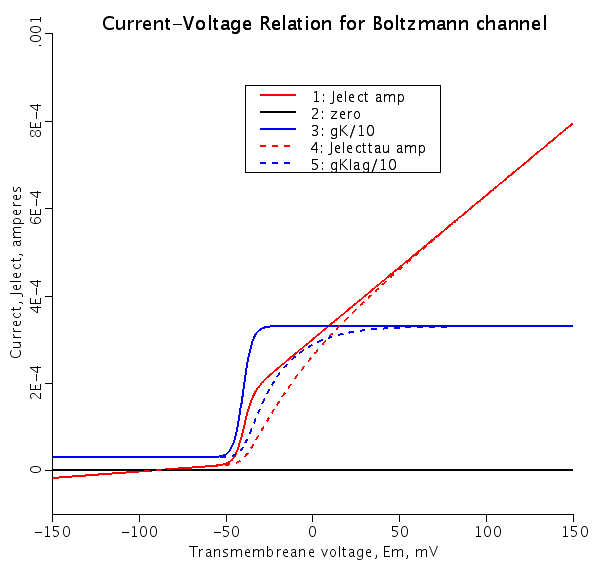Model of Boltzmann gated channel conductance vs. transmembrane voltage for any ion. Conductance change has fixed timelag, tau.
Description
Provides current voltage relationships for potassium currents through a passive leak conductance and through a voltage-gated channel in a membrane. Gives Nernst potentials. Allows changing of gate charges and mean Em for the gate, EKchan, as well as concentrations and temperature in order to explore the Boltzmann relationships. Model is essentially that of Vboltzmann but to demosntrate a time lag in the conformational change and the conductance, the transmembrame voltage Em is changed to be a function ot time, so the independent variable is "t". The lag is not in the Hille description on p19, but later in the book. Model for monovalent cation in water driven by electrochem gradient Membrane separates 2 regions of fixed concentrations, Ko and Ki Solute activities are unity. Currents do not reach S.S. instantaneously but are delayed by a single exponential lag. Single channel conductance about 300 pSiemens; 10^6 chan -> 300 uS. See Notes, section J, within this .proj file for a suggestion to create a tau(t, Em).

Figure: Membrane current (Jelect) and conductance (gK) as a function of transmembrane potential. Current flows through passive leakage and a voltage-gated channel. Dashed lines (Jelecttau and gKlag) show the effect of conductance time lag (Current does not reach S.S. immediately).
Equations
The equations for this model may be viewed by running the JSim model applet and clicking on the Source tab at the bottom left of JSim's Run Time graphical user interface. The equations are written in JSim's Mathematical Modeling Language (MML). See the Introduction to MML and the MML Reference Manual. Additional documentation for MML can be found by using the search option at the Physiome home page.
- Download JSim model MML code (text):
- Download translated SBML version of model (if available):
We welcome comments and feedback for this model. Please use the button below to send comments:
Hille B. Ion Channels of Excitable Membranes, Third Edition. Sunderland, Massachusetts: Sinauer Associates, 2001, 814 pp. page 19, Figure 1.6
Please cite https://www.imagwiki.nibib.nih.gov/physiome in any publication for which this software is used and send one reprint to the address given below:
The National Simulation Resource, Director J. B. Bassingthwaighte, Department of Bioengineering, University of Washington, Seattle WA 98195-5061.
Model development and archiving support at https://www.imagwiki.nibib.nih.gov/physiome provided by the following grants: NIH U01HL122199 Analyzing the Cardiac Power Grid, 09/15/2015 - 05/31/2020, NIH/NIBIB BE08407 Software Integration, JSim and SBW 6/1/09-5/31/13; NIH/NHLBI T15 HL88516-01 Modeling for Heart, Lung and Blood: From Cell to Organ, 4/1/07-3/31/11; NSF BES-0506477 Adaptive Multi-Scale Model Simulation, 8/15/05-7/31/08; NIH/NHLBI R01 HL073598 Core 3: 3D Imaging and Computer Modeling of the Respiratory Tract, 9/1/04-8/31/09; as well as prior support from NIH/NCRR P41 RR01243 Simulation Resource in Circulatory Mass Transport and Exchange, 12/1/1980-11/30/01 and NIH/NIBIB R01 EB001973 JSim: A Simulation Analysis Platform, 3/1/02-2/28/07.

